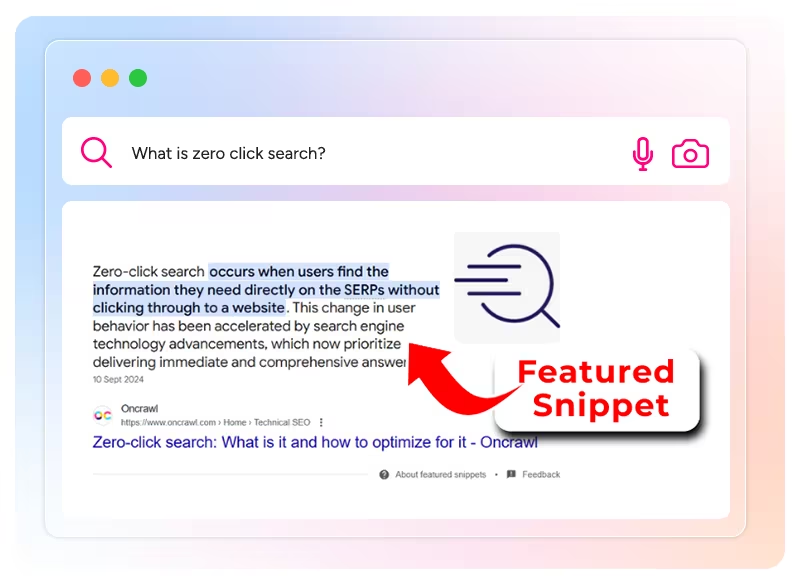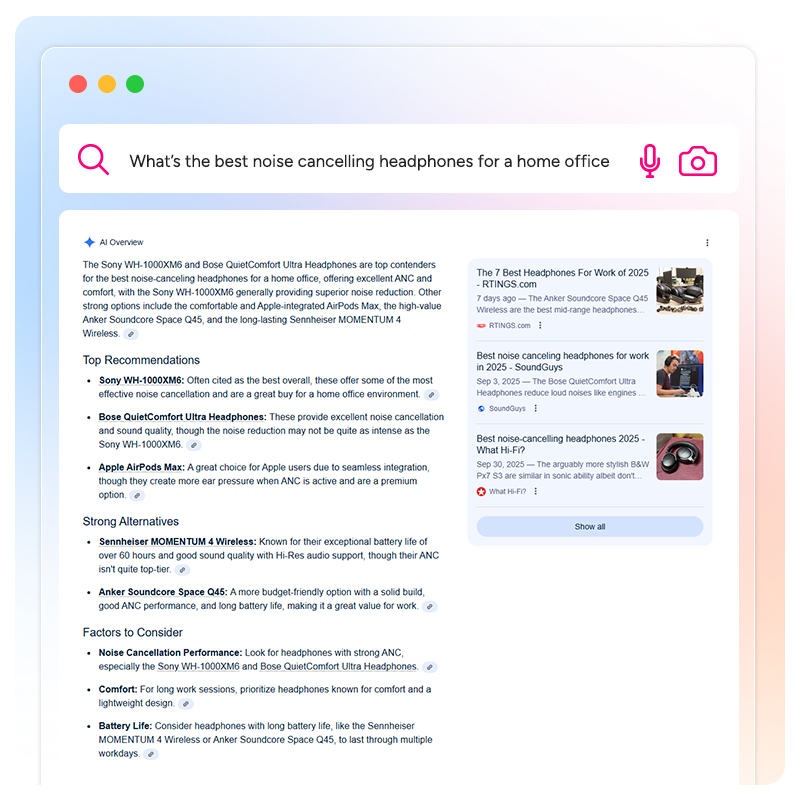The explosion of generative AI and advanced Large Language Models (LLMs) has ushered in an era of zero-click discovery, rendering click-based attribution obsolete in customer journeys initiated by the GAI prompt.
As illustrated by the search results page (SERP), zero-click search occurs when a user finds the information they need—often presented in a Featured Snippet—directly on the SERP without ever clicking through to a website. As consumers increasingly rely on AI agents for research and recommendations, the crucial moments of influence are occurring before the final, trackable click.
This gap in measurement is creating an influence blind spot, preventing brands from accurately evaluating the true ROI of their upper-funnel and indirect channels. Consider a zero-click journey:
 Another example in a zero-click journey could involve use of an intelligent voice assistant. Let’s say a busy professional asks their intelligent voice assistant, “What’s the best noise-canceling headphone for a home office?” The assistant processes context from a vast array of sources (including several of the brand’s social posts, podcast ads, and display campaigns), synthesizes the findings, and presents a final, brand-specific recommendation aloud. The professional later opens the brand’s mobile app (a direct channel) and converts.
Another example in a zero-click journey could involve use of an intelligent voice assistant. Let’s say a busy professional asks their intelligent voice assistant, “What’s the best noise-canceling headphone for a home office?” The assistant processes context from a vast array of sources (including several of the brand’s social posts, podcast ads, and display campaigns), synthesizes the findings, and presents a final, brand-specific recommendation aloud. The professional later opens the brand’s mobile app (a direct channel) and converts.

Without sophisticated intelligence that connects the AI-driven recommendation to the eventual sale, the last-click model incorrectly credits the app for the entire conversion, leading to the undervaluation of high-influence channels and distorted performance evaluations.
This challenge is conceptually similar to earned media value (EMV) where EMV quantifies the monetary worth of organic, unpaid exposure a brand gains from sources like social media, press coverage, or reviews. Both methodologies address the core difficulty of valuing influence that is not tied to a direct, trackable action or a paid placement.
Bottom line: The rise of LLMs and AI is fundamentally changing how consumers discover and buy products, simultaneously creating a new, untracked form of influence that the traditional affiliate model fails to capture. This zero-click affiliation is causing advertisers to undervalue key partners and miss out on significant revenue opportunities. To bridge this measurement gap and turn this hidden influence into measurable opportunity, brands must shift their strategy from focusing solely on traffic and clicks to aggressively optimizing their content for the new reality of AI-driven search. This vital practice is known as Answer Engine Optimization (AEO).
What is Answer Engine Optimization (AEO)?
Answer Engine Optimization (AEO) is the essential, modern evolution of search strategy, specifically tailored to the age of Generative AI. It is the practice of structuring, optimizing, and promoting content so that it can be easily understood, cited, and directly quoted by LLMs and AI-powered search features (like Google’s AI Overviews, Perplexity, or ChatGPT).
While Search Engine Optimization (SEO) focuses on earning high rankings and driving users to a website via a link, AEO shifts the focus to becoming the authoritative source within the AI-generated answer itself.
A Fundamental Shift in Search
The core difference is the user outcome: AI systems are built to provide a single, synthesized answer—a “zero-click” result. This means traffic is no longer guaranteed by ranking #1 on a results page. For a brand to remain visible, its content must be structured to provide clear, concise, and definitive answers that an AI agent will select as the most credible and factual information to present to the user. AEO Intelligence provides the tools to manage this new reality, transforming your content from a ranked link into a trusted AI citation.
How AEO Intelligence Helps Brands Compete
Answer Engine Optimization (AEO) intelligence helps brands keep pace with LLMs by providing the data and insights needed to optimize their presence in AI-driven search, where a significant amount of organic traffic is shifting.
- Identifying the Total Addressable Market (TAM) for GenAI: AEO intelligence can help brands understand the full scope of their potential reach within AI-driven search. Unlike traditional SEO that focuses on keywords, AEO targets conversational, natural language questions that users ask AI chatbots and answer engines. By analyzing the types of questions and topics being asked, brands can identify and expand into new content areas to capture this emerging market share.
- Competitive and Category Analysis: AEO tools can monitor how a brand’s competitors are being cited or mentioned in AI-generated answers. This helps brands identify gaps where their competitors are winning and where they might have an opportunity to increase their visibility. For example, a brand can use AEO intelligence to find instances where an AI response mentions a competitor but not their brand, then create content to fill that gap.
- Real-time Monitoring: Since LLM-generated results can be highly volatile, real-time monitoring is essential. AEO intelligence allows brands to track their presence in different LLMs (like ChatGPT, Perplexity, or Google’s AI Overviews) as it changes, helping them to quickly respond to shifts in AI-driven search trends. This helps ensure that a brand’s narrative remains accurate and up-to-date in AI responses.
- Measuring Week-Over-Week Growth: Traditional SEO metrics like clicks and rankings are less effective in a “zero-click” answer-first world. AEO intelligence provides new metrics, like brand mention share and citation analysis, to measure visibility and sentiment within AI-generated content. By tracking these metrics weekly, brands can gauge the effectiveness of their AEO strategies and ensure they are gaining authority and visibility over time.
The era of the simple click is over; influence now resides in the zero-click AI economy. To capture the untracked revenue of click-free affiliation, brands must implement AEO Intelligence. This shift in strategy allows you to move beyond legacy metrics, measure true brand mention share, and optimize your content for conversational search, ensuring your brand remains visible, relevant, and profitable in the new machine-mediated market.
Want to talk more about your affiliate program’s AEO strategy? Get in touch with us right here.
Related Posts: